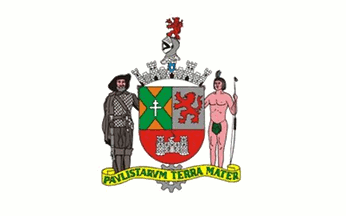 image by
Dirk Schönberger,
2 February 2013
image by
Dirk Schönberger,
2 February 2013Source: http://www.saobernardo.sp.gov.br

Last modified: 2013-02-24 by ian macdonald
Keywords: sao paulo | sao berndardo do campo |
Links: FOTW homepage |
search |
disclaimer and copyright |
write us |
mirrors
 image by
Dirk Schönberger,
2 February 2013
image by
Dirk Schönberger,
2 February 2013
Source:
http://www.saobernardo.sp.gov.br
Other sites:
Area: 406.2 sq km
Population: 701,289
Region: Metropolitan Area of São Paulo
André Pires Godinho, 14 February 2003
Official website at
http://www.saobernardo.sp.gov.br
Dirk Schönberger,
2 February 2013
São Bernardo do Campo is officially said to have been established in 1553 by João Ramalho, as Santo André da Borda do Campo. However, no remains of the old town have been found, therefore the establishment of the modern town is much more recent. Benedictine monks who owned an estate in the region erected in 1717 a chapel dedicated to St. Bernard on the bank of Ribeirão dos Meninos (the site of today's Rudge Ramos borough). In the early 19th century, the village was relocated to the sit of the today's main church of the town. The São Bernardo Colonial Nucleus was established in 1877 on land expropriated from the Benedictine estate. The municipality of São Bernardo was established by Provincial Law of 12 March 1889. The Santo André borough, located closed to the railway station inaugurated in 1867, was made in 1938 the seat of the municipality, renamed Santo André, while São Bernardo was downgraded to a district. The municipality of São Bernardo was reestablished in 1944 and inaugurated on 1 January 1945, its name being changed to São Bernardo do Campo.
Source: Municipal Chamber (law number 181 of 23 October 1952). The white field symbolizes the
peace that the population of the city wants to see, in the center the municipal coat of arms.
André Pires Godinho, 14 February 2003
The flag is prescribed by Municipal Law No. 181 of 23 October 1952. The flag is white with the municipal coat of arms in the middle. White is a symbol of peace. The size of the coat of arms is not prescribed in the Law.
Photos of the flag
http://noticias.r7.com/brasil/fotos/veja-fotos-do-velorio-de-jose-alencar-em-brasilia-20110330-30.html
http://www.flickr.com/photos/francineemilia/3074244244
http://www.flickr.com/photos/renatapaschoal/5626118738
http://www.flickr.com/photos/cbesc/5304285491
The coat of arms is prescribed by Municipal Law No. 180 of 23 October 1952, reestablishing [word for word] Municipal Law No. 251 of 20 December 1926. The coat of arms, designed by Afonso d’Escragnolle Taunay, summarizes the historical past of the town since the establishment in 1553 of Vila de Santo André da Borda do Campo. "Portuguese, rounded-off shield, surmounted by a mural crown [argent], over the central gate an escutcheon azure a fleur-de-lis argent, the whole surmounted by a helmet ensigned with a lion gules. Per fess, 1a. Or a St. Andrew's cross vert superimposed with a St. Bernard's patriarchal cross [argent], 1b. Argent a lion gules, 2. Gules a city wall argent ensigned with an arm holding a sword argent. The shield supported dexter by a pioneer holding a hunting rifle and sinister by an Indian holding a bow the two proper. Beneath the shield a scroll or inscribed with the motto 'PAULISTARUM TERRA MATER' in letters vert, superimposed to a cog wheel proper.
The lion in the second quarter comes from the arms of the Ramalho family. The cog wheel represents industry. The helmet ensigned with the lion comes from the coat of arms of Martin Afonso de Souza. The escutcheon azure with the fleur-de-lis argent symbolizes the patron saint of the municipality, the Blessed Virgin.
http://www.saobernardo.sp.gov.br/comuns/pqt_container_r01.asp?srcpg=historia_simbolos_brasao - Municipal website
Ivan Sache, 10 February 2013